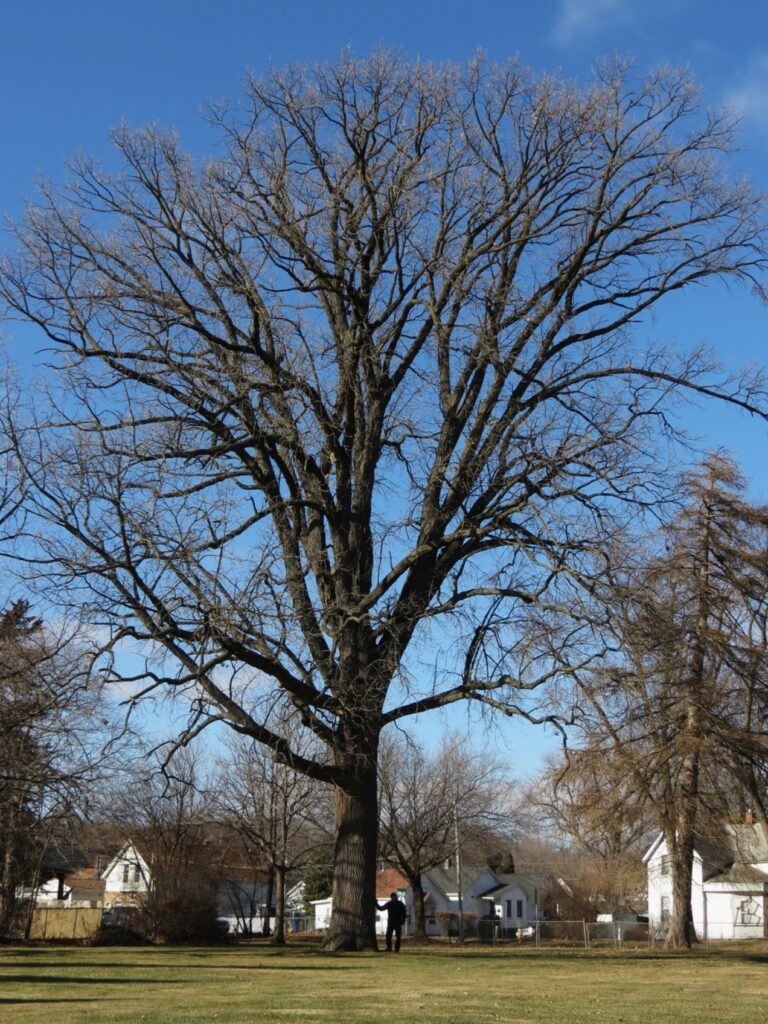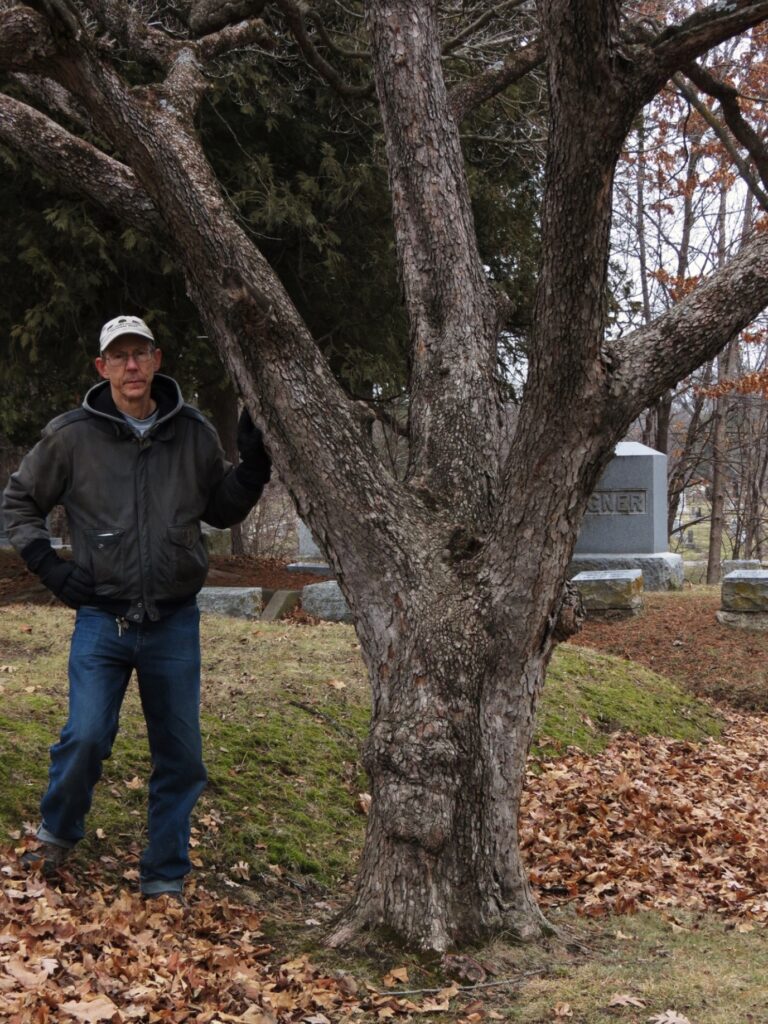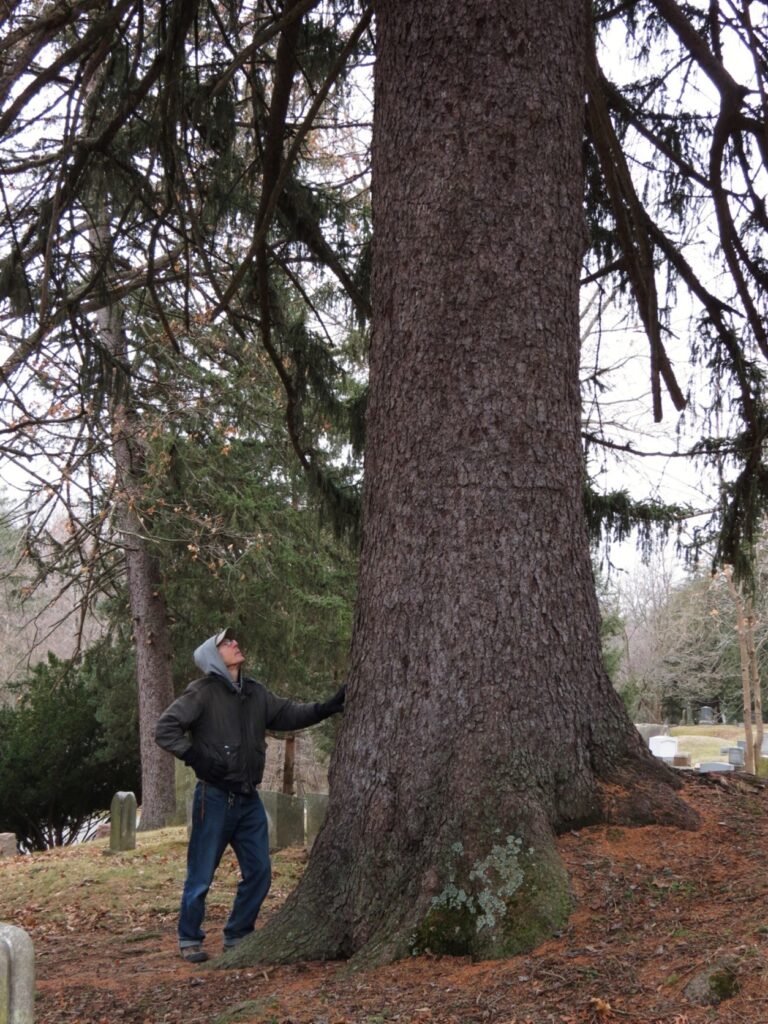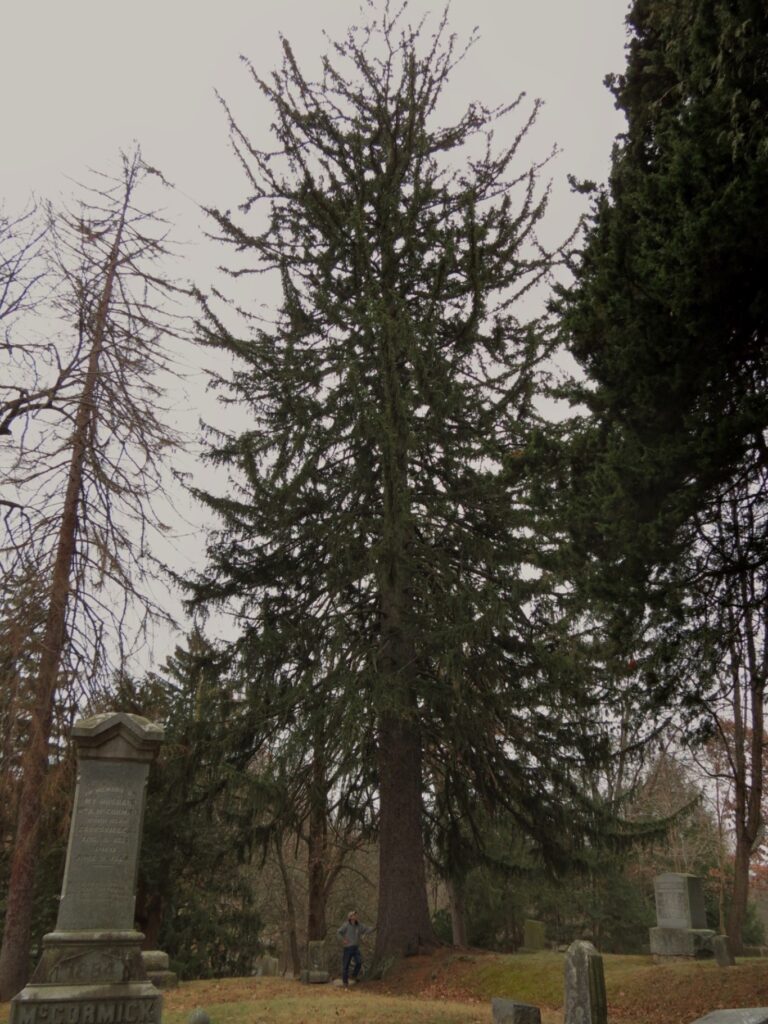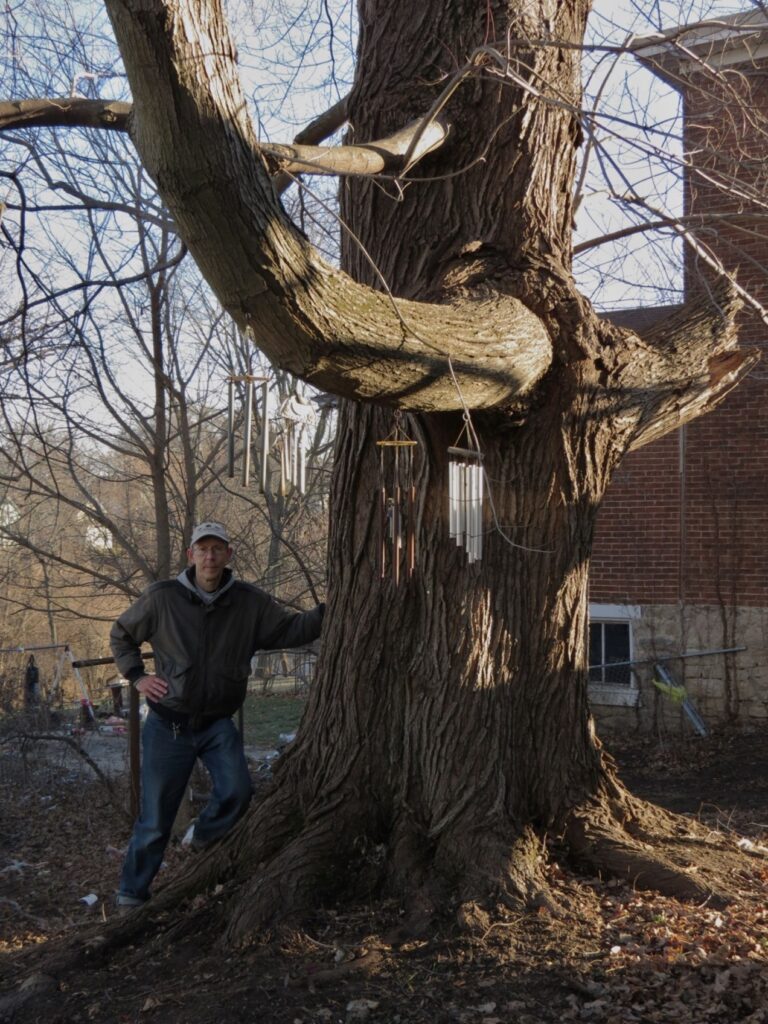Mark Rouw BIG Tree: Updated Report
Iowa Big Tree Report for July Through December of 2022
Submitted By Mark Rouw, Iowa Big Tree Field Representative
The second half of 2022 may not have been as productive as the first half of the year, but there were some significant finds which are described in this report. I’m hoping this account will not be as detailed and time consuming as the previous one, but that remains to be seen.
One of the first trees measured in the second half of the year was a good sized Kentucky coffeetree at Big Creek State Park. Despite a rather large trunk and an impressive crown spread it would not rank high on the spreadsheet for the species.
July 17th – I measured a Scotch pine on the Drake University campus that would not have compared favorably to past Scotch pines, but today it qualifies as a state champion. In the late seventies and early eighties, I located a number of Scotch pines with trunks exceeding 10’. A few of these were over 12’ and the largest one had a circumference that surpassed 16’! That tree became the national champion in 1981 but like almost every other mature Scotch pine, it died just a few years later.
One really big one survived, and at the time, it was large enough to be a national champion. All I had to do was update the measurements and nominate the tree. The tree stood in the cemetery at Lineville. When I reached the cemetery it didn’t take long for me to realize the tree was gone. I found out what happened from a man who was digging a grave in the cemetery. He told me, there was a honey bee hive in the tree and a kid was stung. Apparently the tree was taken down to make sure this didn’t happen again! It was many years before I located another large Scotch pine which stood in Estherville. It was healthy, but it was removed for the construction of building! I found the much smaller new champion on the Drake University campus to have the following dimensions:
Circ. 8.67’, height 64.5’, spread 39.5’, index 178, rank # 1
Oct. 11th – I measured a Des Moines Kentucky coffeetree that I have watched mature over the last 50 years. I wish I had measured this tree many years ago so I could have tracked the growth. I determined the tree which grows in Union Park to have these dimensions:
Circ. 8.67’, height 86.42’, spread 66’. Index 199, rank # 10. There were two larger coffeetrees in Union Park but they have been gone for many years.
While visiting Union Park, I updated measurements on the largest pin oak in the park. The measurements are as follows:
Circ. 13.17’, height 86.25’, spread 90.415, index 266.854; rank # 9, circa 1973, circumference approximately 8.42’
Oct. 16th – I measured what may be the second largest walnut in DesMoines. Although it is a big tree for this area, with the following dimensions, it does not rank among the biggest in Iowa.
Circ. of 11’, a height of 81.5’, spread of 93.5’, index 236.83, rank # 37
Nov. 29th – I measured a walnut in Bettendorf that had very similar dimensions to the above tree from Des Moines. Here are the measurements for the Bettendorf walnut:
Circ. 10.98’, height 86.67’, spread 92.25’, index 240.233, rank # 34
In east Davenport, I measured a white mulberry that I first noticed a few years earlier. I have seen some impressive mulberries over the years but this one may be the most impressive of them all! Here are the dimensions:
Circ. 15.17’, height 58.25’, spread 80.75’, max. Spread 92.25’, index 260.188, rank co-champion
Scott Carlson and I measured the co-champion mulberry located in the Davenport Memorial Park on May 6th, 2021 and we found it to have the following dimensions:
Circ. 14.83’, height 61.83’, spread 66.25’, index 256.393, rank # 2, co-champion
Another co-champion white mulberry from Polk County had 260.25 total points on November 7th of 2021 but it was cut down in 2022. Interestingly, I was contacted after the tree was removed to see if it was a significant tree!
It was really too late in the day to measure any more trees but as usual, I had to try and get one more measured for the day. The one more tree was a catalpa on Bridge Ave. It had been a while since I tried measuring a tree in the dark, and by the time I was measuring the spread, it was very dark! Although I had permission to measure the tree the owner lived elsewhere. I ‘m sure the young lady that came out of the house must have been quite startled when she discovered a stranger lurking by the big tree! Despite the less- than- ideal conditions, I believe the following measurements are precise:
Circ. 17.25’, height 85.5’, spread 71’, index 307.25, rank # 9
November 30th – I started the day by measuring a pin oak in western Davenport. I first saw this tree many years ago, but I finally made arrangements to measure the tree. I was a little disappointed because I was expecting the tree to be larger, but it turned out to be a very respectable pin oak with these dimensions:
Circ. 13.83’, height 89’, spread 73.5’, index 273.375, rank # 6
The next tree to measure was a sycamore in the backyard of a home on W. 1st St. in Davenport. I determined the tree to have these dimensions:
Circ. 16.58’, height 107.25’, spread 99’, index 330.83, rank # 9
This tree stands in an old part of town, so I was assuming the tree was planted well over one hundred years ago, but I was shocked by what the owner told me. She said her husband planted the tree in 1958 or 1959. She said the tree was purchased from Mass Nursery and during transport the young tree extended out of the window of their 1957 Chevy!
Not far from the sycamore, I measured a bur oak on private property that I had noticed some years earlier. I knew the tree was tall, but I was pleasantly surprised at the girth and spread. I found the oak to have these dimensions:
Circ. 14.625’, height 93.92’, spread 94.5’, index 293.045, rank # 5
The next tree for the day was a very large catalpa on W. 3rd St. in Davenport. I determined the tree to have the following dimensions:
Circ. 19.42’, height 76.08’, spread 66.5’, index 325.705, rank # 1, and co-champion
Another catalpa on W. 3rd St. appears to have a circumference of at least 18’, but I was unable to contact the owner prior to my visit and no one was home when I went to the door. I was able to estimate the height from across the street and I determined the height was about 77.5’.
I had permission to measure a large river birch on W. 9th St. in Davenport. I found the birch to have the following dimensions:
Circ. 10.83’, height 57.92’, spread 90.5’, index 209.545, rank # 2
It was getting late’, but I had to try and squeeze another tree in for the day. Years ago, I noticed a large catalpa on E. 14th St. in Davenport. Ever since I found it, I have been very curious to know the dimensions of this catalpa, but previous attempts to contact two different owners were unsuccessful. Even though it was getting dark and I was not optimistic about my chances of getting permission, I mustered up enough courage to knock on the door. The owner’s son was cooperative so I was finally able to measure the tree! I would like to go back and verify my measurements when there are no issues with darkness, but I’m fairly confident the following measurements are accurate:
Circ. 16.17’, height 83.58’, spread 72.25’, index 295.643, rank # 10
December 4th – I headed to northeast Iowa, primarily to check out several rock elms, Ulmus thomasii. My first measured tree for the day was a good sized Kentucky coffeetree in Cedar Falls. Here are the dimensions I found for the tree:
Circ. 10.54, height 82.75’, spread 67.25’, index 225.5, rank # 3.
Also in Cedar Falls, I was able to update the measurements of a Douglas-fir that I first measured in 2010. The new owner gave me permission to measure the tree and this is what I determined:
Circ. 8.17’, height 73.58, spread 45.5, index 182.955, rank # 12
The next stop was Fayette County to update the height of the tallest tree in Iowa. I was glad to see the top of the tree was still intact and the tree appeared to be healthy. Here are the dimensions for this exceptional white pine:
Circ. 8.46’, height 151.42’, spread 36.5’, index 262.045, rank # 37
The next stop was in Winneshiek County to update measurements of a former champion Norway spruce. I found the tree to have the following dimensions:
Circ. 17.33’, height 82’, spread 66’, index 306.5, rank # 1
With the updated measurements this Norway spruce reclaims the status of champion. The last time I measured this tree, I thought it was in poor shape. The top several feet of the leader were dead and I wasn’t very optimistic about its’ future. To my surprise the tree recovered from that setback and new growth had actually surpassed the dead top that was the highest point!
In Decorah, I went to an address where there were reported to be three rock elms growing on the boulevard. On a previous trip, I found a rock elm and a red elm growing side by side near downtown Decorah. The location for the three rock elms was provided to me by Peter van der Linden. They were not exceptionally large but how often do you find rock elms that were planted? Here are the dimensions of the largest of the three rock elms:
Circ. 6.67’, height 64.25’, spread 42’, index 154.75, rank # 14
Peter’s wife Judy did some research and learned a nurseryman from Decorah, Joel Dayton was propagating and selling rock elms around the turn of the century. An old photo of the house with the three rock elms, provided by the adjacent owner, shows the house from around the turn of the century. The photo is not the best but you can just barely see a couple of young trees with straight trunks on the boulevard. I think these trees were young rock elms. With the help of the photo and the information from an old newspaper, I would estimate the three rock elms on the parking are at least 130 years old.
December 6th – I headed to Malanaphy Springs which is a state preserve, to measure a couple of rock elms that I didn’t have time to measure on previous visits. If you walk to the far end of Malanaphy Springs, you are rewarded with the site of a beautiful spring, but for me the best thing about the preserve is the rock elms that can be seen here. I measured two rock elms and here are the dimensions of the largest one which turned out to be the largest of all of the rock elms at Malanaphy Springs:
Circ. 6.75’, height 94.92’, spread 56’, index 189.92, rank # 3
After leaving the preserve, I headed to a cemetery at Lansing to focus on large Norway spruce and the champion balsam fir. Here are the updated measurements for the balsam fir:
Circ. 5.83’, height 94.42’, spread 25.75’, index 170.858, rank # 1
Some of the most impressive Norway spruce in Iowa live in the Lansing Cemetery. I updated the dimensions of three of the largest and I measured a tall one that I had never measured before. Despite moderate snow at the time, when I fired my TruPulse 200X two or three times I was able to replicate the height. Here are the dimensions of the Norway spruce that was measured for the first time:
Circ. 9.67’, height 112.08’, spread 48.5’, index 240.205, rank 17
The circumference and the spread are nothing special but with a height of 112.08’ it is second only to the tallest Norway spruce in Dubuque that reaches a height of 113’.
It was getting late in the day, but I was still hoping to measure two more trees in Dubuque. I had plenty of day light for the silver maple which wasn’t as large as I had hoped but it was pretty dark by the time I found my way to a much anticipated walnut. Here are the dimensions of the walnut:
Circ. 14’, height 84.75’, spread 87.125, index 274.531, rank # 8
I should get paid overtime for putting in such long hours! Wait a minute; I’m a volunteer so never mind.
December 7th – I headed to Maquoketa where I had permission to measure a silver maple. At 14.5’ the trunk circumference was not what I was hoping to find but with a spread of 108’ that dimension met my expectations. I saw several other noteworthy trees in Maquoketa but I only measured two other trees. I measured a cottonwood that had these dimensions:
Circ. 26.33’, height 71.75’, spread 92.5’, index 410.875, rank # 4
This tree stood on commercial property with no houses or buildings close by. The grade around the tree had recently been altered. You could still see the tracks from the heavy equipment. It was also very evident that the low area around the tree had been filled in so there was no basal flare visible on the tree. They also managed to make a significant gouge in the trunk which was now at ground level. Who knows how many other injuries to the tree were covered up by the several feet of added soil?
The other tree I measured in Maquoketa was a white spruce on residential property. I determined the following dimensions for the spruce:
Circ. 7’, height 84.33’, spread 34.5’, index 181.125, rank # 4
After leaving Maquoketa, I headed for the champion hemlock located on private property in southern Jackson County. I had not visited this outstanding tree since it was first measured in 2016. I updated the measurements and determined the champion hemlock to have the following dimensions:
Circ. 12.08’, height 84.67’, spread 50’, index 242, rank #1
Although it was getting late in the day, I decided to try and get one more tree measured before heading back home. For several years I had been wanting to measure a dawn redwood in Clinton and on this day it finally happened. Here are the dimensions of the largest known dawn redwood in Iowa:
Circ. 9.58’, height 72.08’, spread 56.5’, index 201.205, rank # 1
December 12th– I went to Davenport and teamed up with Scott Carlson for part of the day. For many years I have known of a large Kentucky coffeetree in Davenport but my previous attempts to get permission for measurement and nomination of this tree had failed. Recently my persistence paid off so this time, I had permission! Here are the dimensions for this exceptional coffeetree:
Circ. 11.67’, height 74.7’, spread 66’, index 231.2, rank # 1
There are at least three large catalpas in Davenport that grow on the property line which complicates the task of gaining permission. Scott and I measured one of these lot line catalpas on the east side of town. We found this catalpa to have the following dimensions:
Circ. 18.33’, height 81.5, spread 66.25’, index 318.063, rank # 4, and co-champion
Despite being the fourth largest catalpa, it is less than 3 percent smaller than the number one catalpa, so it qualifies as a co-champ. There are eight Iowa catalpas that fall between 325 total points and 315 total points!
The next tree on the agenda was a red maple on Spring St. in Davenport. This city tree stands on the boulevard and the surface roots are as extensive as any I can remember. Let’s just say, there is a good portion of the boulevard that doesn’t need mowing because there is a solid mat of roots! We determined the red maple to be quite respectable with these dimensions:
Circ. 9’, height 66.42’, spread 70.5’, index 192.125, rank # 4
It may be of interest to some of you that there was a red maple in Davenport that had a maximum spread of over 100’ but it was cut down before I could get precise measurements! There was also a silver maple in Davenport that had a huge single trunk and a maximum spread of at least 125’ that was also cut down before I was able to get it measured.
Scott had commitments so I was on my own for the rest of the day. In Eldridge, I measured a Douglas-fir that I first noticed many years ago. With a ranking of # 16 this was not remarkable but the owner and I hit it off quite well. He was an artist and he gave me a print of his goldfinch painting!
While in Eldridge, I noticed an unusual oak. After examining some leaves, it appeared to be a hybrid between a white oak and a swamp white oak. The leaves averaged smaller than either a white oak or a swamp white oak.
By this time, it was getting late but I had to try and measure one more tree. I had permission to measure a bur oak in Davenport that I first noticed many years ago. I remember being very disappointed the first time I saw the tree. It would have been such a beautiful tree but several of the largest lateral limbs had been cut leaving long stubs. The tree didn’t turn out to be as big as I had hoped, but despite losing so much of the crown, the maximum spread was 103’.
December 28th – Despite several inches of snow on the ground, I made arrangements to meet Andy Dahl in Bonaparte where we were supposed to meet with a man who would take us to a white pine that was reported to be huge. The height, which was measured with a drone, was reported to be 108’ which would be exceptional for an open grown white pine. The height combined with a reported trunk girth of 13.5’ meant we could be measuring one of the largest white pines in Iowa! As we were approaching the site, I was becoming skeptical. After turning into the lane to the old abandoned house, I could tell the height dimension had been overstated. Here are the dimensions Andy and I came with for this pine:
Circ. 13.67’, height 86.75’, spread 69.75’, index 268.188, rank #25
The house with the big pine was very run down, but what a show place it must have been at one time. It was one of those impressive houses with columns in the front that must have been built for a wealthy family many years ago. I had been told there was also a large pecan in the backyard of the same property. After finishing up the pine we proceeded to measure the pecan. The pecan did not disappoint with the following dimensions:
Circ.11.17’, height 86.75’, spread 95.25’, index 244.563, rank # 7
After measuring the pecan, Andy and I went to Ft. Madison. Our first stop was Rodeo Park at the north edge of town but we didn’t stay long. We decided to concentrate on a tuliptree in an old neighborhood of Ft. Madison. We determined the following dimensions for this very respectable tuliptree:
Circ. 14.58’, height 99.25’, spread 86.5, index 295.875, rank # 11
Andy had to head home but I still had some daylight so I kept measuring trees. There used to be a very large basswood in Fort Madison, and a few years ago I contacted the owner only to learn it was no longer standing. Today, I came across another basswood growing on the boulevard in Fort Madison. It wasn’t nearly as large as the one that was lost but I decided it was big enough to measure. Here are the dimensions of the basswood:
Circ. 12.5’, height 84.08’, spread 70’, index 246.08, rank # 6
It was getting pretty late but I wanted to make one more stop before going to Burlington to spend the night. The last stop would be to update, at least the trunk anyway, of a previously measured catalpa near Weaver. I found the catalpa to have the following dimensions:
Circ. 19.92’, height 63.5’, spread 74.25’, index 290.25, rank # 3, and co-champion
December 29th – The first stop of the day was Aspen Grove Cemetery, which is not officially an arboretum but it has many wonderful trees. The state champion baldcypress stands in Aspen Grove but I decided to measure another one that I had never measured before. Here are the dimensions of this baldcypress:
Circ. 11.92’, height 62.5’, spread 62’, index 219.75, rank # 6
Next, I measured two scarlet oaks. Neither tree was particularly large, but since there were so few scarlet oaks on the spreadsheet the size of these trees these was significant. These two trees rank number three and four.
The next tree to be measured was a Norway spruce which I had seen previously but I had never measured. I found the tree to have these dimensions:
Circ. 10.75’, height 98.25’, spread 52’, index 240.25, rank # 16
This tree stands very close to the co-champion red pine that I measured last spring. I measured the circumference of the red pine and learned it was 7.67’ which is an increase of one inch since last year.
From the red pine, I went to visit the state champion baldcypress which is one of my favorite trees in the cemetery. Here are the dimensions I found for this tree:
Circ. 12.5’, height 83.5’, spread 66.25’, index 250.063, rank # 1
I measured this tree last spring and the circumference and spread increased but the height was more than 1’ less. There was no visible damage to the top of the tree so this discrepancy is unacceptable to me! I’m anxious to return so this discrepancy can be resolved. I did return in the spring of 2023 and I found the height to be 84.75. Apparently I did not hit the highest point with my previous measurement.
I had not updated the dimensions of the second largest known mockernut hickory in Iowa, which stands in the southeast part of Aspen Grove Cemetery, since it was first measured in 2009. Here are the updated measurements for this hickory:
Circ. 8.17’, height 87’, spread 61.25’, index 200.313, rank # 2
The next tree I measured was a black oak which stands on private property. I’m not totally convinced this tree qualifies as having a single trunk, but it was difficult for me to make a determination. For now, I have given the tree the benefit of the doubt and here are the dimensions for this black oak:
Circ. 16’, height 76.5’, spread 97.79’, index 292.948, rank # 3
There are very few chestnut oaks in Iowa and the only mature ones stood on private property in Burlington. One of these two chestnut oaks was considerably larger than the other one but unfortunately the larger one of the two died. I measured the remaining chestnut oak and found it to have these dimensions:
Circ. 7’, height 74.92’, spread 42.83’, index 169.628, rank # 1
December 30th – I updated the dimensions of a large white oak in Burlington that I last measured in 2011. Here are the dimensions of the oak:
Circ. 16.21, height 69.08, spread 91.5’, index 286.455, rank# 4
Interestingly there is another white oak in Burlington that has a total of 286.375 points which is almost identical to the tree above!
After updating the white oak, I went back to Aspen Grove Cemetery which was not far away. The first tree I measured In Aspen Grove was a flowering dogwood that I had seen before but had never measured. I had neglected this tree because it has a low fork, which in the past would have made the tree ineligible. Some years ago the rules were changed and now low forking trees are eligible. I am not a fan of this change because the circumference measurement already favored trees with large trunks. Since the circumference measurement guideline change, there has been a proliferation of low forking trees, many of which are multi-stemmed trees posing as national champions and excluding the deserving champions which have a single trunk! Here are the dimensions of the flowering dogwood:
Circ. 5’ (@28’), height 33.33’, spread 44’, index 104.33, rank # 1
Not too far from the dogwood was a Norway spruce that I had seen before but only from a distance. Sometimes a tree may look huge from a distance but as you get closer you realize it’s nothing special. Other times a tree may not look like anything exceptional but as you approach the tree you discover it’s really big. As I approached this Norway spruce, I realized it was much bigger than I thought. When I reached the tree I was in awe. I thought to myself, “This may be the most impressive Norway spruce I have ever seen!” Despite having a trunk circumference about three feet less than the champion, the Aspen Grove tree is only two points shy of being an Iowa co-champion. If the volume between the spruce in Aspen Grove and the one in Winneshiek County were to be compared, I would bet on the one from Aspen Grove to come out on top! Here are the dimensions of this amazing Norway spruce from Aspen Grove Cemetery:
Circ. 14.17’, height 108.33’, spread 67’, index 295.08, rank # 2
On a previous visit to Burlington, I noticed a large red maple in someone’s backyard but when I knocked on the door no one answered. A subsequent letter also failed to get results. I decided to try another time to make contact with the owner. I knocked on the door, and again no one answered. I was feeling quite discouraged as I assessed the tree from the public sidewalk. I was all set to leave when a car pulled up to the curb in front of the house. Perhaps this was the owner. My enthusiasm was tempered by the possibility they may not want to cooperate. It turned out to be the owner, and not only did she grant me permission, she loved the tree! She proceeded to tell me that she remembered when her mother planted the tree about 67 years ago. Not only did this red maple turn out to be a co-champion, it even had a few more points than the former outright champ from Grinnell College! Here are the dimensions of this outstanding red maple:
Circ. 11.25’, height 71.5’, spread 72.5’, index 224.375, rank # 1, and co-champion
The big red maple is not without problems, including the remains of a large limb that broke off some time ago. The stub is about 10” in diameter and it has significant decay.
Before it was too dark to see, I had permission to measure an impressive silver maple in Burlington. I measured the trunk and found the circumference to be 16.21’. It was a wonderful tree with a nice single trunk and the bark on the trunk was made up of large thick peeling plates. The height was approximately 83’ and the spread was probably greater. It was time for me to head home, so the spread measurement would have to wait for another time.
I want to give a special thanks to Scott Carlson for sharing my interest in the big trees and accompanying me on several occasions. Scott and Leah even put me up for the night or should I say, they put up with me for the night! I also want to thank the IAA for their generous support!
I have included photographs of a few of the trees described above.
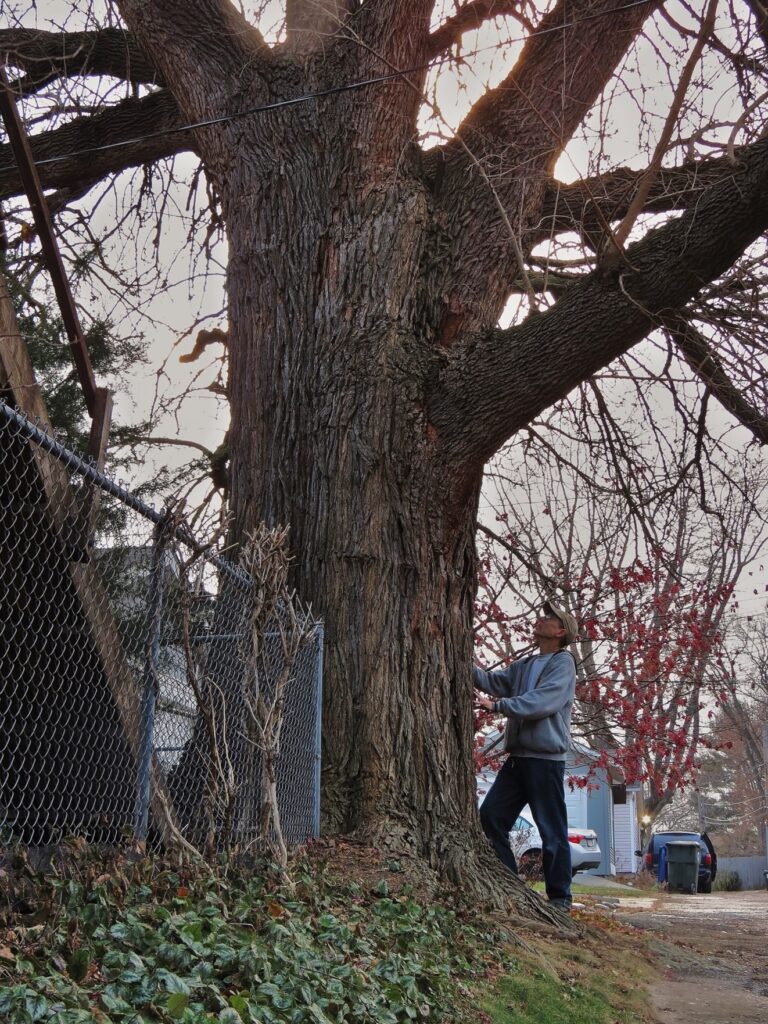
With a massive trunk and a tremendous spread, this white mulberry from Davenport is a deserving new co-champion.
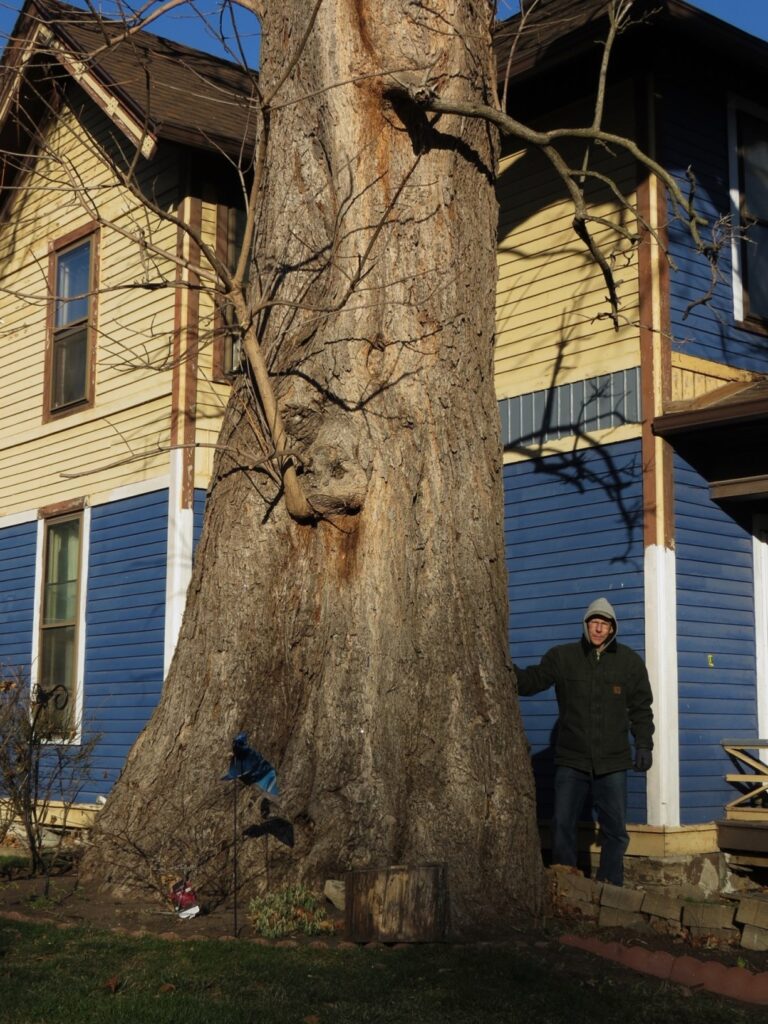
With nearly 326 points, this recently measured co-champion catalpa from Davenport has more total points than any other known catalpa in Iowa!
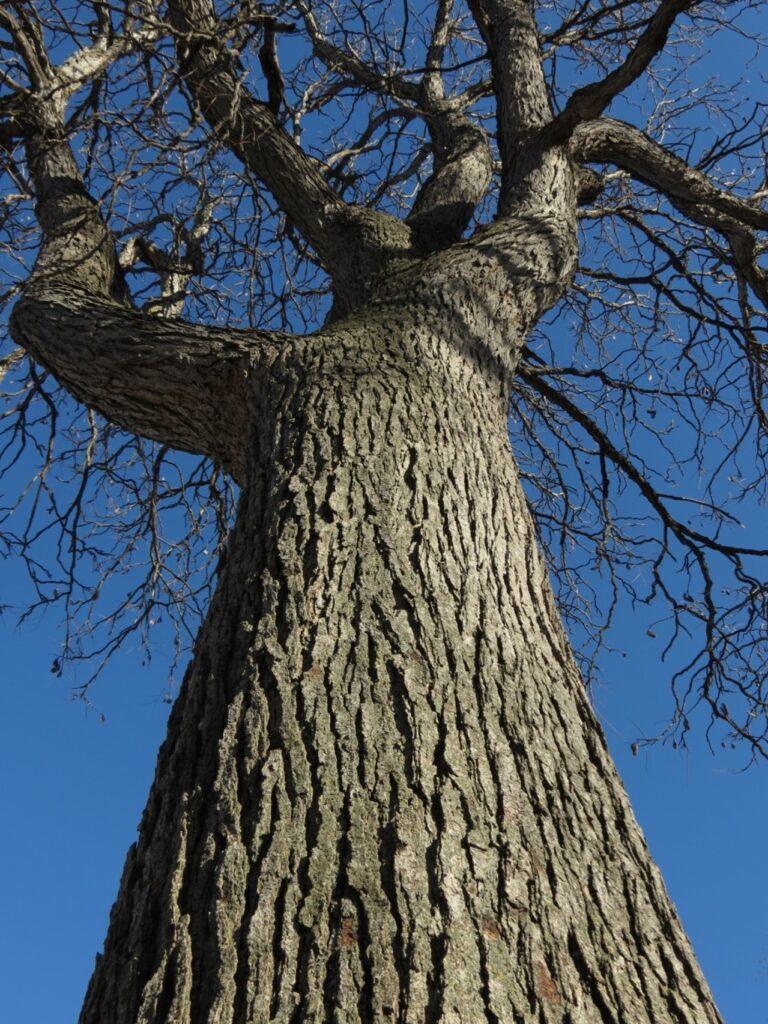
This beautiful coffee tree from Cedar Falls ranks as the third largest in Iowa and qualifies as a co-champion.
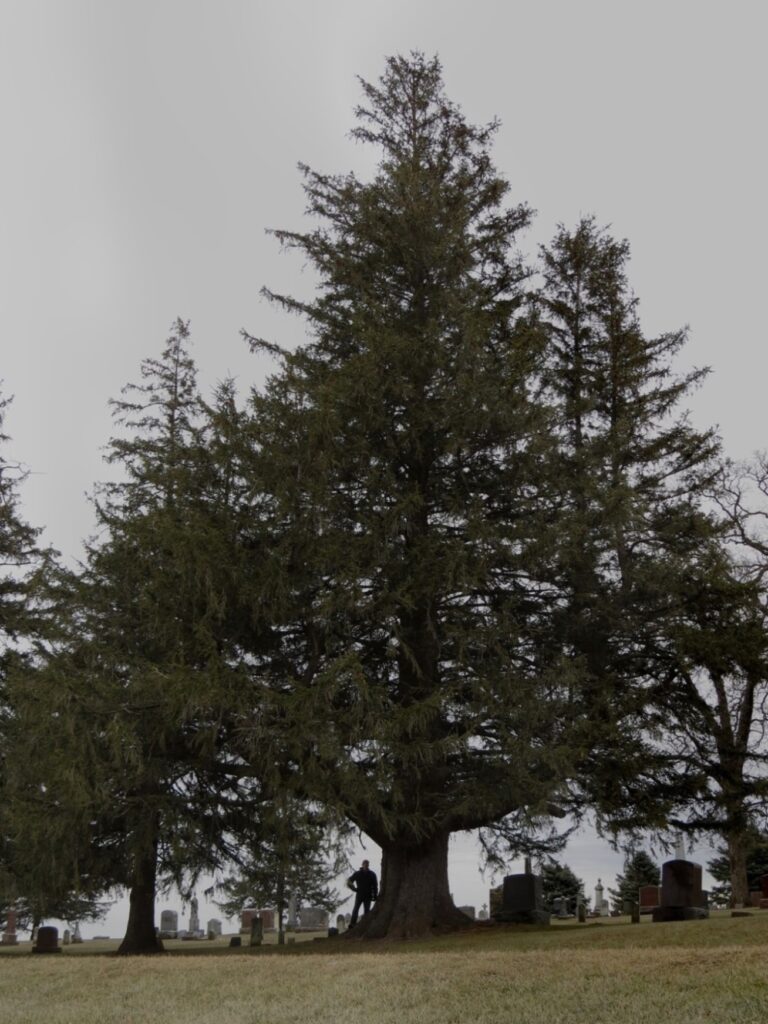
With recently updated measurements, this former champion Norway spruce from Winneshiek County reclaims the title of state champion. The circumference, which measures 17’4”, is greater than any other known Norway spruce in Iowa!

If you look closely at the two green arrows in this photograph taken around 1900, you should be able to see two small trees with straight trunks. I believe these were rock elms planted by nurseryman Joel Dayton around the turn of the century. There are still three rock elms on the boulevard adjacent to this home in Decorah today.
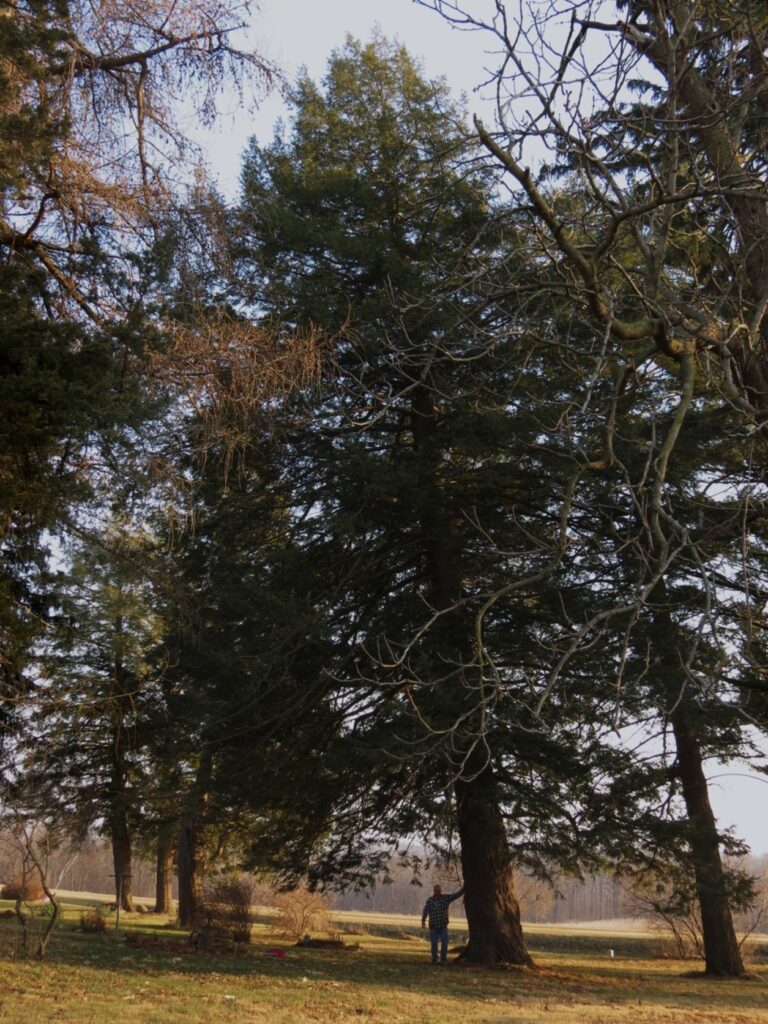
With a circumference of 12’1” and a height of 84’8” this champion hemlock from Jackson County is 22 points larger than the next largest Iowa hemlock.

This co-champion red pine lives in Aspen Grove Cemetery, Burlington. One in Dubuque County is slightly larger overall but with a trunk that measures 7’8”, this one has the largest circumference.

